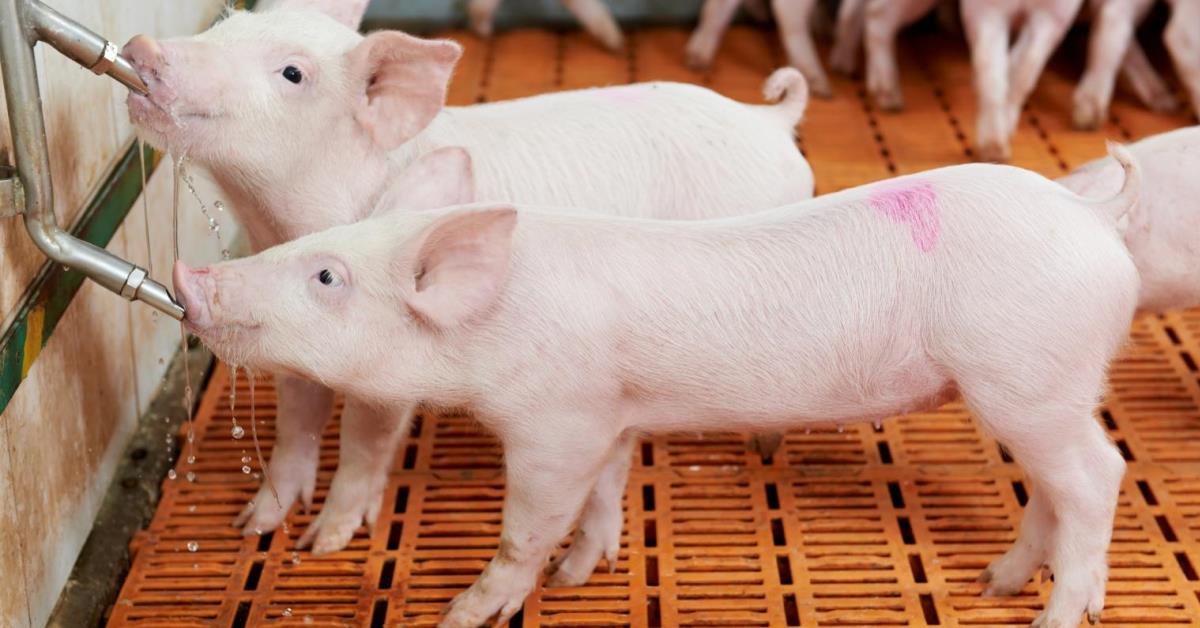
During your daily barn walk-through, you check the temperature, ventilation, feed, and health of the pigs. But are you forgetting something? Did you check the water? Water is often the most overlooked nutrient, even though it is the most important nutrient that fulfills numerous physiological functions necessary for life. The need for access to fresh, clean water becomes increasingly important as the ambient temperature rises heading into the dog days of summer. There are several things that you can immediately implement to ensure that your pigs are drinking and eating to their full potential.
The table below will give you a broad guideline on where water usage should be depending on the size of the pig. One of the best ways to determine if your pigs are getting enough water is to observe their behavior during times when they are active and not being disrupted by chore activities. If there are more than 3 pigs in line at a water source during an active period water is limiting. When it comes to the breeding herd look for sows that are drinking for prolonged periods of time when water is available (trough systems), or sows are licking/sucking water off the floor.
|
Pig Weight |
< 12 lbs |
12-30 lbs |
30-75 lbs |
75-150 lbs |
150-Market |
Breeding Herd |
|
Nipple Height, in |
4-6 |
6-12 |
12-18 |
18-24 |
24-30 |
30-36 |
|
Pigs/Nipple |
10 |
10 |
10 |
12-15 |
12-15 |
12-15 |
|
Flow Rate (cups/min) |
2/3 |
1 |
1 ½ |
2 |
3 |
4 |
|
Daily Intake |
0.2-0.5 qt |
0.5-1.0 gal |
1.0-1.5 gal |
1.5-2.5 gal |
1.5-4.5 gal |
2-7 gal |
In addition to water availability, water quality should also be assessed. Issues can be diagnosed via sight, smell, and pig observation. If the water appears to be an off color, cloudy, having sediment or a foul odor the quality of water should be assessed further. Discoloration of walls or equipment around water sources could also point to high levels of iron or manganese. Pigs are also good gauges for water quality issues with refusal to drink upon entering a site or scouring when there isn’t a pathogen present. Generally, local labs do water testing and will provide sample kits to you send in your water samples. You can also work with your veterinarian or Hubbard representative to collect and submit water samples.
There are several options ranging from low to high cost that you can do to improve water quality. You can flush the lines between turns of pigs at each site (highly recommended), use a low-cost acidifier to inhibit bacterial growth, adding chlorine to the water or installing a water purification system.
Water is an important nutrient and often an overlooked tool in swine production. Acid-Pak 4-Way® is a great tool that producers can use in weaned pigs, pigs that are stressed, or health challenged pigs to help increase water intake and, subsequently, feed intake. Acid-Pak 4-Way modifies the gut pH, reducing pathogen load and improving gut health. Due to the acid components, it will also clean the biofilm from your water lines. Acid-Pak 4-Way is an inexpensive way to increase water intake and improve pig health for only $0.01 per pig per day. In newly weaned pigs it is recommend that Acid-Pak 4-Way be provided for the first 7 days post-arrival at the rate of 1 qt per gallon of stock solution (1:128). In situations where pigs are going to be stressed or go through a health challenge Acid-Pak 4-Way can be provided for 5-7 days. Remember pigs must have access to clean, fresh water for any water product to be effective.
As you head out for your next barn walk-through be sure to add water on your list of things to observe and check-out.
For more information regarding water in your swine operation please check out the Water Quality sections in the Swine Management guides located on our website under Swine Sales & Marketing Pieces.
- Log in to post comments
